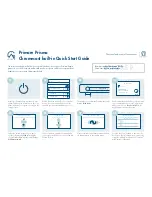
1.0
1.2
1.4
.8
.6
1.0
1.2
1.4
.8
.6
FIG 1 CHARACTERISTIC OF AIR
PRESSURE
VOLUME
(bars)
(M /Kg)
3
Fig. 1 shows the single ended nature of air. We can push on it and raise the pressure an
arbitrary amount, but we cannot pull on it. We can only let it relax and fill a space as it will;
the pressure will never go below "0". As we push on air, the increase in pressure is greater
than the corresponding decrease when we allow air to expand. This means that for a given
motion of a diaphragm acting on air, the positive pressure perturbations will be slightly greater
than the negative. From this we see that air is phase sensitive.
As a result of its single ended nature, the harmonic content of air is primarily 2nd order, that is
to say most of the distortion of a single tone is second harmonic. The phase of this distortion
reflects the higher positive pressure over the negative.
Air's transfer curve also shows also that it is monotonic, which is to say its distortion products
decrease smoothly as the acoustic level decreases. This is an important element that has
often been overlooked in audio design and is reflected in the poor quality of early solid state
amplifiers and D/A and A/D converters. They are not monotonic: the distortion increases as
the level decreases.
The usual electrical picture of an audio signal is as an AC waveform, without a DC
component. Audio is represented as alternating voltage and current, where positive voltage
and current alternates with negative in a reciprocal and symmetric fashion. This fiction is
convenient because it lends itself to the use of an energy efficient design for amplifier power
stages known as push-pull, where a "plus" side of an amplifier alternates operation with a
"minus" side. Each side of a push-pull amplifier handles the audio signal alternately; the
"plus" side supplying positive voltage and current to the loudspeaker, and the "minus" side
supplying negative voltage and current.
Problems with push-pull amplifier designs associated with crossover distortion have been
discussed elsewhere at length, and one of the primary results is non-monotonicity. Class B
and many AB designs have distortion products that dramatically increase with decreasing
signal. This is reduced greatly by Class A mode, but crossover distortion remains as a lower
order discontinuity in the transfer curve.
For reproducing music as naturally as possible, push-pull symmetric operation is not the best
approach. Air is not symmetric and does not have a push-pull characteristic. Sound in air is a






























